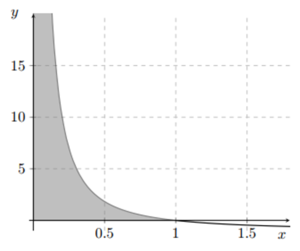Science:Math Exam Resources/Courses/MATH103/April 2017/Question 06 (a)
{{#incat:MER QGQ flag|{{#incat:MER QGH flag|{{#incat:MER QGS flag|}}}}}}
• Q1 (a) • Q1 (b) • Q1 (c) • Q1 (d) • Q1 (e) (i) • Q1 (e) (ii) • Q1 (e) (iii) • Q1 (f) • Q2 (a) • Q2 (b) (i) • Q2 (b) (ii) • Q2 (c) • Q3 (a) • Q3 (b) • Q3 (c) • Q3 (d) • Q4 • Q5 • Q6 (a) • Q6 (b) • Q7 (a) • Q7 (b) • Q7 (c) • Q8 (a) • Q8 (b) • Q8 (c) • Q9 (a) • Q9 (b) • Q9 (c) • Q9 (d) • Q9 (e) •
Question 06 (a) |
|---|
|
Consider the function . (a) Calculate the area, , bounded by the -axis, -axis and (shaded area in figure) or show that it does not exist |
|
Make sure you understand the problem fully: What is the question asking you to do? Are there specific conditions or constraints that you should take note of? How will you know if your answer is correct from your work only? Can you rephrase the question in your own words in a way that makes sense to you? |
|
If you are stuck, check the hint below. Consider it for a while. Does it give you a new idea on how to approach the problem? If so, try it! |
Hint |
|---|
|
First, set up the integral. Then, as the integral could be improper, integrate the integrand first. |
|
Checking a solution serves two purposes: helping you if, after having used the hint, you still are stuck on the problem; or if you have solved the problem and would like to check your work.
|
Solution |
|---|
|
The area that we wish to determine is the left shaded area, which equals to the following integral
Integrating the integrand gives, by the Power Rule of Differentiation,
We see that is defined everywhere on but undefined at . Hence, we have an improper integral, and it equals to
Evaluating this using the Fundamental Theorem of Calculus now gives
We note that and that . Hence, the integral diverges and the area is
|
{{#incat:MER CT flag||
}}









![{\displaystyle (0,1]}](https://wiki.ubc.ca/api/rest_v1/media/math/render/svg/7e70f9c241f9faa8e9fdda2e8b238e288807d7a4)






